| Author |
Message |
|
Matthew Velardo
|
 Posted: Mon 08 Jun, 2015 4:17 pm Post subject: Posted: Mon 08 Jun, 2015 4:17 pm Post subject: |
 |
|
| Dan Howard wrote: | | Matthew Velardo wrote: | | I cut my sample in half to see how many "layers" I had. I counted about 22 layers on linen, give or take a few in other areas. The rags that I used were mostly no smaller than 12cm in any direction, so although the were stuffed in, they did create several thick layers of linen. Of course, this would not be as strong as a gambeson with 20 individual layers of cloth, but may be comparable to a one with say, 15-16 layers. |
I thought that you used loose stuffing rather than multiple layers. What you have there is actually pretty good. All you need is a lot more rows of quilting, spaced around a cm or so apart, and you'll have a decent test patch. Keep in mind that a lot of the linen that is commercialy available today would barely be good enough to use as rags in the past. The closest modern equivalent to armour-grade linen would be what you find in expensive linen tablecloths. |
Right. I have noticed that there are MANY different weights of linen fabric- everything from super thin and light sheer weave to a heavy canvas. I did have the chance to pick up some nice old linen tablecloths at thriftshops.... but since there are all still in one piece (very large pieces at that!) I thick I'll save them for another project. Most of what I used for this project is a medium weight though. It is still pretty tough stuff.
Of course, this is all experimental... for reenacting purposes I could stuff it with cotton so long as it looks authentic from the outside... no one is going to come over and rip open the seems to make sure that you sewed the gambeson with several layers of heavy weight linen! 
I'd just like feel how a more authentically made gambeson would wear on the body and how well it moves, etc.
|
|
  |
 |
|
Mikael Ranelius
|
 Posted: Tue 09 Jun, 2015 1:45 am Post subject: Posted: Tue 09 Jun, 2015 1:45 am Post subject: |
 |
|
| Mart Shearer wrote: | | It gets to be nigh impossible to push a needle through 30 layers of fabric. It must have been easier to assemble thinner sub-assemblies thinned at the edges. Sew six layers and stack the components 4 times, before placing in a shell of 2-6 more layers. |
It's difficult I'll give you that, but achievable using a 10 cm/ 4 in needle. It depends on the thickness and density of the fabric though.
| Dan Howard wrote: | | The closest modern equivalent to armour-grade linen would be what you find in expensive linen tablecloths. |
Are there any sources which specify the quality of armour-grade linen?
|
|
  |
 |
Dan Howard

|
 Posted: Tue 09 Jun, 2015 6:13 am Post subject: Posted: Tue 09 Jun, 2015 6:13 am Post subject: |
 |
|
| Mikael Ranelius wrote: | | Are there any sources which specify the quality of armour-grade linen? |
We don't need them. We have plenty of physical examples. The upcoming Tudor Tailor book should have lots of this kind of information.
http://www.tudortailor.com/news/whats-next-op...f-defence/
Author: Bronze Age Military Equipment, Pen and Sword Books
|
|
  |
 |
|
Mikael Ranelius
|
 Posted: Tue 09 Jun, 2015 10:10 am Post subject: Posted: Tue 09 Jun, 2015 10:10 am Post subject: |
 |
|
| Dan Howard wrote: | | Mikael Ranelius wrote: | | Are there any sources which specify the quality of armour-grade linen? |
We don't need them. We have plenty of physical examples. The upcoming Tudor Tailor book should have lots of this kind of information.
http://www.tudortailor.com/news/whats-next-op...f-defence/ |
Just the kind of book I've been waiting for; I'll keep my eyes open for its release.
|
|
  |
 |
|
Matthew Velardo
|
 Posted: Thu 11 Jun, 2015 11:18 am Post subject: Posted: Thu 11 Jun, 2015 11:18 am Post subject: |
 |
|
| Dan Howard wrote: | | Mikael Ranelius wrote: | | Are there any sources which specify the quality of armour-grade linen? |
We don't need them. We have plenty of physical examples. The upcoming Tudor Tailor book should have lots of this kind of information.
http://www.tudortailor.com/news/whats-next-op...f-defence/ |
This looks like an excellent resource! Thank you for sharing.
Here is the progress on my test coif so far: (see attachments)
As you can see, it's not very pretty.... hopefully I'll have some more practice with stitching done before I start the gambeson.
After I finish stitching the other side, I will probably add some more rows of stitching just to add a bit more strength. Right now the rows are about 3-4 cm apart.
Based on the thickness, I'm guessing that the coif has somewhere around 15 layers of linen. It turned out to be much heavier than I expected.
While doing some googleing, I came across this image from Stara Manufaktura.
[url] http://staramanufaktura.blogspot.com/[/url]

Meant of course to go under a mail coif. Does anyone know of any evidence of similar coifs worn independently of mail?
 Attachment: 316.21 KB Attachment: 316.21 KB
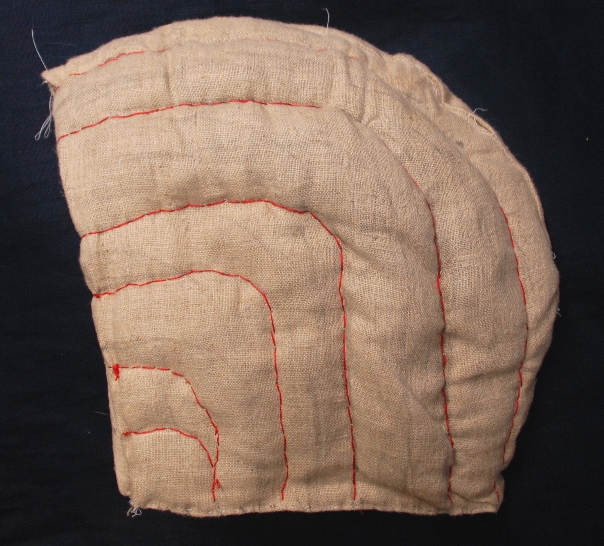
 Attachment: 329.8 KB Attachment: 329.8 KB
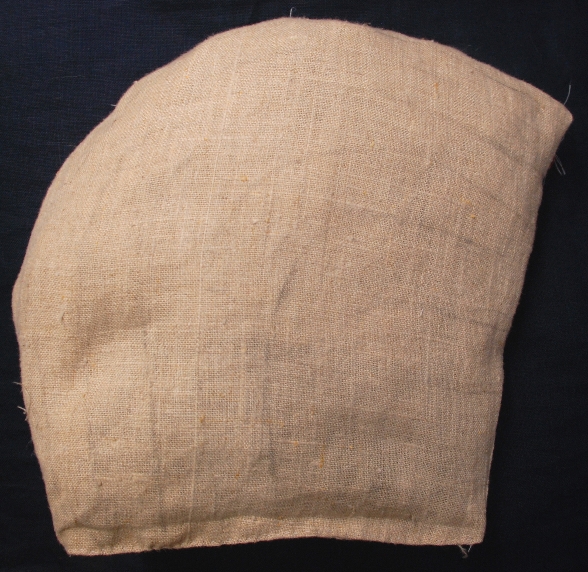
 Attachment: 243.07 KB Attachment: 243.07 KB
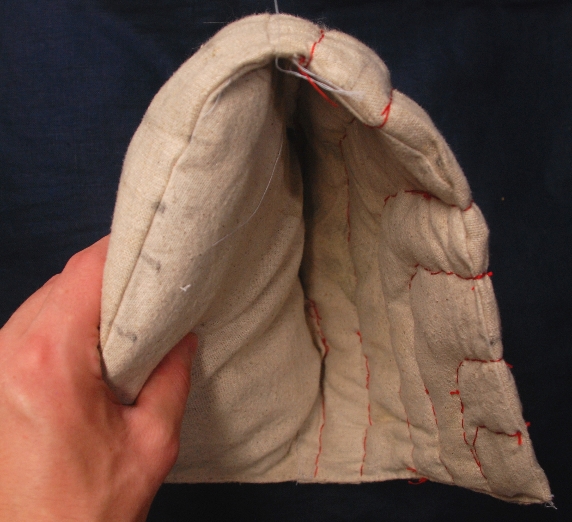
|
|
  |
 |
|
Mart Shearer
|
 Posted: Thu 11 Jun, 2015 11:31 am Post subject: Posted: Thu 11 Jun, 2015 11:31 am Post subject: |
 |
|
| Matthew Velardo wrote: | | Meant of course to go under a mail coif. Does anyone know of any evidence of similar coifs worn independently of mail? |
Something like these?
Holkham Picture Bible, British Library Add. MS 47682, fo. 40r, 1327-1335
http://www.bl.uk/manuscripts/Viewer.aspx?ref=add_ms_47682_f040r
 Attachment: 31.14 KB Attachment: 31.14 KB
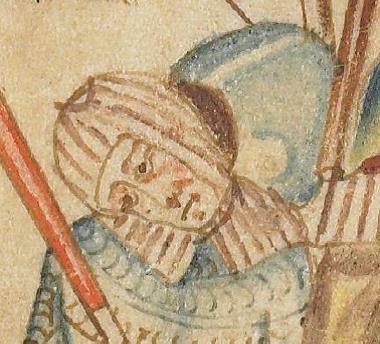
 Attachment: 41.39 KB Attachment: 41.39 KB
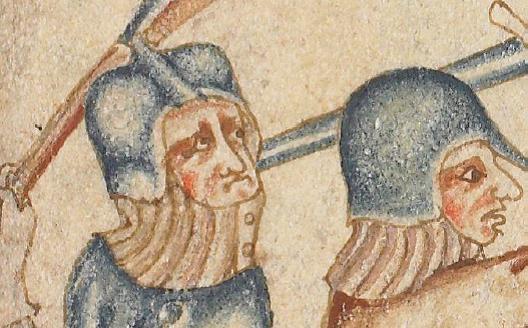
ferrum ferro acuitur et homo exacuit faciem amici sui
|
|
  |
 |
|
Mart Shearer
|
 Posted: Thu 11 Jun, 2015 11:39 am Post subject: Posted: Thu 11 Jun, 2015 11:39 am Post subject: |
 |
|
Or the Maciejowski Bible examples:
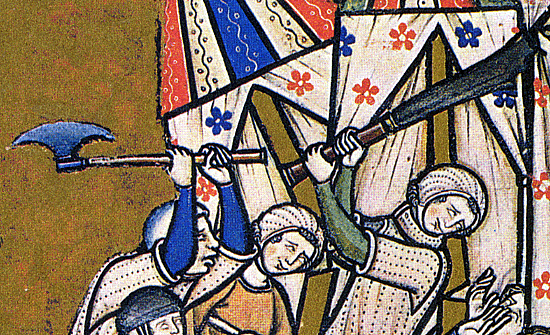
ferrum ferro acuitur et homo exacuit faciem amici sui
|
|
  |
 |
|
Matthew Velardo
|
 Posted: Thu 11 Jun, 2015 12:35 pm Post subject: Posted: Thu 11 Jun, 2015 12:35 pm Post subject: |
 |
|
| Mart Shearer wrote: | | Matthew Velardo wrote: | | Meant of course to go under a mail coif. Does anyone know of any evidence of similar coifs worn independently of mail? |
Something like these?
Holkham Picture Bible, British Library Add. MS 47682, fo. 40r, 1327-1335
http://www.bl.uk/manuscripts/Viewer.aspx?ref=add_ms_47682_f040r |
Exactly like those! Thanks!
I was familiar with the smaller "skull cap" shaped coifs depicted in the Maciejowski Bible and elsewhere, but hadn't noticed coifs with neck coverings in other sources.
So just recapping what we have so far:
1. There are no known references to quilted armor in the 11th Century, though it is certainly possible... but speculative at best.
2. We DO know that quilted armor, be it an independent piece or a jack designed to go over chainmail existed in the 12th-16th centuries, though it went through many changes.
|
|
  |
 |
|
Mart Shearer
|
 Posted: Thu 11 Jun, 2015 1:58 pm Post subject: Posted: Thu 11 Jun, 2015 1:58 pm Post subject: |
 |
|
Fabric armors were worn both above and beneath mail, as well as independently from the second half of the 12th century through the 16th century.
ferrum ferro acuitur et homo exacuit faciem amici sui
|
|
  |
 |
Dan Howard

|
 Posted: Thu 11 Jun, 2015 2:57 pm Post subject: Posted: Thu 11 Jun, 2015 2:57 pm Post subject: |
 |
|
| Matthew Velardo wrote: | | After I finish stitching the other side, I will probably add some more rows of stitching just to add a bit more strength. Right now the rows are about 3-4 cm apart. |
For underpadding that is fine. For standalone armour the rows of quiting need to be closer together. Keep in mind that underpadding for the head tends to be a lot thicker than that used for the rest of the body.
| Quote: | | Based on the thickness, I'm guessing that the coif has somewhere around 15 layers of linen. It turned out to be much heavier than I expected. |
Textile and leather armour always turns out to be heavier than people expect. It is not a lighter alternative to metal. The whole point of using metal is that, pound for pound, it provides better protection than any other alternative. Textile armour wasn't worn because it was light. It wasn't worn because it was cheap. There were other reasons that we are just starting to figure out - such as comfort, or fashion, or, as Giovanni Michiel said, because it is best at resisting the "shock of arrows" (whatever that means).
Author: Bronze Age Military Equipment, Pen and Sword Books
|
|
  |
 |
|
Pieter B.
|
 Posted: Thu 11 Jun, 2015 4:12 pm Post subject: Posted: Thu 11 Jun, 2015 4:12 pm Post subject: |
 |
|
| Matthew Velardo wrote: | | There were other reasons that we are just starting to figure out - such as comfort, or fashion, or, as Giovanni Michiel said, because it is best at resisting the "shock of arrows" (whatever that means). |
I briefly brought this up in the "effectiveness of ranged weapons" thread.
To quote Mike Loades:
| Quote: | While the fight went on, for many minutes with
each assault, and with French knights and men-at-arms engaging English
knights and men-at-arms, the archers probably continued to ply their
trade. This is what we see in the art. It required rapid shooting and precision
shooting and was, I believe, where the archers did their main work.
Men reeling from the impact of arrows, concussed and ataxic,bruised,
broken and wounded, were easy pickings |
| Quote: | Ataxia is a neurological condition that results in the loss of muscle co-ordination and loss
of balance. It can be caused by blunt trauma to the brain and can manifest in what is
commonly called being punch-drunk. |
In another test Joe Gibbs shot one of his powerful warbows at a target wearing a gambeson at extremely close range and while it failed to penetrate a sensor behind it recorded impact forces as high as 300 lbs.
I think the analogy of a gambeson to a bullet proof vest still stands. Someone wearing a gambeson hit by such a close range arrow wouldn't see arrows bouncing off without feeling anything. Just like someone wearing a bullet proof vest he would still feel the hit.
*For those who don't know how bulletproof vests work
http://www.ponderweasel.com/shot-wearing-a-bulletproof-vest/
|
|
  |
 |
|
Matthew Velardo
|
 Posted: Thu 11 Jun, 2015 7:07 pm Post subject: Posted: Thu 11 Jun, 2015 7:07 pm Post subject: |
 |
|
Here are some designs for future projects:
I haven't yet come across any pictorial evidence of a "Type 3" coif though. Would it be unreasonable to have the face covered at times?
 Attachment: 105.32 KB Attachment: 105.32 KB

|
|
  |
 |
|
Mart Shearer
|
 Posted: Thu 11 Jun, 2015 8:37 pm Post subject: Posted: Thu 11 Jun, 2015 8:37 pm Post subject: |
 |
|
| Matthew Velardo wrote: | Here are some designs for future projects:
I haven't yet come across any pictorial evidence of a "Type 3" coif though. Would it be unreasonable to have the face covered at times? |
Does the image source list any supporting documents for that style? I've never seen anything like it, and suspect it's a poor mis-interpretation of early mail ventails.
The Type 1 & 2 have already been provided from the Maciejowski Bible and Holkham Bible. The Type 4 is an espalier, like this example from the Manesse Codex.
 Attachment: 82.42 KB Attachment: 82.42 KB
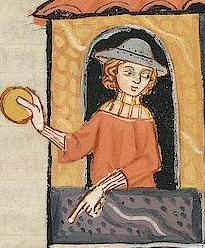
ferrum ferro acuitur et homo exacuit faciem amici sui
|
|
  |
 |
|
Mart Shearer
|
 Posted: Thu 11 Jun, 2015 8:47 pm Post subject: Posted: Thu 11 Jun, 2015 8:47 pm Post subject: |
 |
|
| Dan Howard wrote: | | Matthew Velardo wrote: | | Based on the thickness, I'm guessing that the coif has somewhere around 15 layers of linen. It turned out to be much heavier than I expected. |
Textile and leather armour always turns out to be heavier than people expect. It is not a lighter alternative to metal. The whole point of using metal is that, pound for pound, it provides better protection than any other alternative. Textile armour wasn't worn because it was light. It wasn't worn because it was cheap. There were other reasons that we are just starting to figure out - such as comfort, or fashion, or, as Giovanni Michiel said, because it is best at resisting the "shock of arrows" (whatever that means). |
I suspect one of the major attractions of textile armors was the fact that almost every woman who could sew, given sufficient materials, could assemble one at home.
ferrum ferro acuitur et homo exacuit faciem amici sui
|
|
  |
 |
Benjamin H. Abbott

|
 Posted: Fri 12 Jun, 2015 12:36 am Post subject: Posted: Fri 12 Jun, 2015 12:36 am Post subject: |
 |
|
| Dan Howard wrote: | | Textile and leather armour always turns out to be heavier than people expect. It is not a lighter alternative to metal. The whole point of using metal is that, pound for pound, it provides better protection than any other alternative. Textile armour wasn't worn because it was light. It wasn't worn because it was cheap. There were other reasons that we are just starting to figure out - such as comfort, or fashion, or, as Giovanni Michiel said, because it is best at resisting the "shock of arrows" (whatever that means). |
This isn't so clear. Various period source indicate or explicitly state that fabric armor was lighter. Giovanni Michiel wrote the the following:
| Giovanni Michiel, 1557 wrote: | | As to defensive armour they have nothing of importance, either because they do not think about it, or that they hold it in no account, as whether on foot or on horseback when fighting against each other they prefer being nimble (expediti) and active, in order to be able to move forward and backward, and to run and leap, rather than to weight themselves with armour, which would impede their movements, though their persons would be much more secure; so generally for the defence of the head they use nothing but certain light sallets (alcune cellade leggieri) like ordinary skull-caps, rather than morions or anything of greater importance; and for the body they either use some sort of breastplate (qualche petto di corsaletto) which guards the forepart, although indifferently, or else more willingly (especially those who have the means) some jack (zacco) or shirt of mail; but what they usually wear are certain canvas doublets, quilted with many layers, each of which is two inches or more in thickness; and these doublets are considered the most secure defence against the shock of arrows. Upon their arms they place plates of mail, put lengthways, and nothing else. |
I can't find it at the moment, but I recall reading a Spanish source that noted the weight of plate harness compared with cotton armor. It also mentioned how arrows tended to ricochet off of plate and thus possibly wound other soldiers while arrows stuck in cotton armor.
From Alan Williams, we additionally know that the pound-for-pound protective ability of iron/steel plate increases with thickness. A 1mm plate takes rather less energy per pound to pierce than a 3mm plate.
Last edited by Benjamin H. Abbott on Fri 12 Jun, 2015 1:59 am; edited 1 time in total
|
|
  |
 |
Dan Howard

|
 Posted: Fri 12 Jun, 2015 1:39 am Post subject: Posted: Fri 12 Jun, 2015 1:39 am Post subject: |
 |
|
| Mart Shearer wrote: | | I suspect one of the major attractions of textile armors was the fact that almost every woman who could sew, given sufficient materials, could assemble one at home. |
We know that it was the tailor who made textile armour and not the armourer. The Linen Armourers was a separate guild from the regular armourers. Ffoulkes says that in 1272 this guild was instituted as "The Fraternity of Tailors and Linen Armourers of Linen Armour of St. John the Baptist in the City of London," and that Richard II and Edward III were honourary members. By the 15th century they were simply refered to as the Gilda Armourarii, which is what the regular armourers were called as well, so it is impossible to tell from most documents which guild is beiing referred to.
| Benjamin H. Abbott wrote: | | This isn't so clear. Various period source indicate or explicitly state that fabric armor was lighter. Giovanni Michiel wrote the the following... |
There is a better translation earlier in this thread. There is nothing in there that suggests that textile armour is lighter than metal armour. The passage says that ALL of their armour is light - including breastplates, jacks, mail, and layered doublets. He says that their canvas doublets were preferred because they were best against the "shock of arrows", not because they were lighter.
| Quote: | | I recall reading a Spanish source that noted the weight of plate harness compared with cotton armor |
I'm not sure whether that will help. Cotton defenses usually only cover the torso and arms. Plate harness covers the entire body. Almost half of the weight of a harness is in the legs. This is the distinction that Michiel was making as well. None of the people he was talking about covered themselves in armour - especially the legs - because they preferred to remain nimble in battle. All of the armours he described only covered the upper body. The breastplate provided the least coverage of all and was only worn by those who could afford nothing better. Which tells us that textile armour was not cheap. Poor people wore munitions plate, not jacks.
Author: Bronze Age Military Equipment, Pen and Sword Books
|
|
  |
 |
|
Mart Shearer
|
 Posted: Fri 12 Jun, 2015 5:46 am Post subject: Posted: Fri 12 Jun, 2015 5:46 am Post subject: |
 |
|
| Dan Howard wrote: | | Benjamin H. Abbott wrote: | | This isn't so clear. Various period source indicate or explicitly state that fabric armor was lighter. Giovanni Michiel wrote the the following... |
There is a better translation earlier in this thread. |
Dan and I were participating in a discussion including this very passage on Armour Archive. I copy myself....
http://forums.armourarchive.org/phpBB3/viewto...p;t=178394
https://books.google.com/books?id=sUpKAAAAYAAJ&pg=PA61&lpg=PA61
| Quote: | | e per la persona ovvero qualche petto di corsaletto che arma la parte dinanzi benchč meschina mente ovvero pių volentieri quelli massime che uč hanno il modo qualche giaco o camicia di maglia ma l'uso pių frequente č di alcuni giubboni di canevaccio imbottiti a molti doppj alti due dita e pių riparo tenuto sicurissimo contro la furia delle freccie e sopra le braccia alcune liste di maglia per il lungo e non altro |
| Quote: | | ..... and for the body they either use some sort of breastplate (qualche petto di corsaletto) which guards the forepart, although indifferently, or else more willingly (especially those who have the means) some jack (zacco) or shirt of mail; but what they usually wear are certain canvas doublets, quilted with many layers, each of which is two inches or more in thickness; and these doublets are considered the most secure defence against the shock of arrows. Upon their arms they place plates of mail, put lengthways, and nothing else. |
giaco = jack
camicia di maglia = mail shirt
giubboni di canevaccio imbottiti = jupon of canvas padded
doppi alti due dita = double high, two fingers (perhaps an inch and a half, 4cm, rather than two inches)
liste di maglia = "lists" of mail
ferrum ferro acuitur et homo exacuit faciem amici sui
|
|
  |
 |
|
Mart Shearer
|
 Posted: Fri 12 Jun, 2015 6:11 am Post subject: Posted: Fri 12 Jun, 2015 6:11 am Post subject: |
 |
|
| Dan Howard wrote: | | Mart Shearer wrote: | | I suspect one of the major attractions of textile armors was the fact that almost every woman who could sew, given sufficient materials, could assemble one at home. |
We know that it was the tailor who made textile armour and not the armourer. The Linen Armourers was a separate guild from the regular armourers. Ffoulkes says that in 1272 this guild was instituted as "The Fraternity of Tailors and Linen Armourers of Linen Armour of St. John the Baptist in the City of London," and that Richard II and Edward III were honourary members. By the 15th century they were simply refered to as the Gilda Armourarii, which is what the regular armourers were called as well, so it is impossible to tell from most documents which guild is beiing referred to. |
While this is undoubtedly the case for some, the fact that ffoulkes also cites gambesons being made by women also shows it to sometimes be a cottage industry. In the AA thread, I also bring up the example in the Bannatyne Manuscript's The Wowing of Jok and Jynny. The poor suiter who has nothing of note for a dowry has managed to save up fyve fidder of raggis to stuff ane jak; or 5 buckets of rags to stuff a jack. It seems dubious that he would have these assembled by a professional tailor. Early assizes require mail and plates for men of means and gambesons and aketons for men lower down the scale. We know the costs of aketons could be more than mail, as the aristocrats preferred silk coverings, probably professionally assembled, but we also see jacks or gambesons being the required armor of those who could fabricate them on their own.
ferrum ferro acuitur et homo exacuit faciem amici sui
|
|
  |
 |
|
Pieter B.
|
 Posted: Fri 12 Jun, 2015 8:05 am Post subject: Posted: Fri 12 Jun, 2015 8:05 am Post subject: |
 |
|
Some Flemish sources also mention Jacks/Gambesons as being made by a guild. I am not sure if the fact that you could possible make it yourself makes is that more attractive to do so. The late medieval period, like ours, had a consumer culture in which skilled professionals with equipment keep production time and cost down, then there is the whole guild regulations thing.
I think the main attraction of it was that it was cheap regardless of whether you had it made for your or made it yourself.
|
|
  |
 |
|
Mart Shearer
|
 Posted: Fri 12 Jun, 2015 9:58 am Post subject: Posted: Fri 12 Jun, 2015 9:58 am Post subject: |
 |
|
Randal Storey's thesis:
http://virtuabis.free.fr/Technology%20and%20M...ngland.pdf
| Quote: | APPENDIX I
Average Prices of English Arms from the years 1294-1339 (in pence)
Item....................Average...........Low..........High..........Sample Size
Aketon................67d..................12d...........160d......... 60
Pair of plates......167d................27d............320d.........12
Gambeson.........28d......................................................06
Hauberk.............138d.................60d...........264d..........14
|
The wide variety in costs of pairs of plates can be explained by covering (e.g. hemp or fustian vs. silk velvet), iron nails of silver, quality of the metal in the plates.
The variety in the cost of hauberks (lorica) can be explained by varying degrees of coverage (e.g. long sleeves with mittens vs. short sleeves), ring size (smaller rings require much more labor), and type of metal (wrought iron vs. steel).
The variety in costs of aketons can be explained by variants in facing material (e.g. canvas vs. silk or leather), and stuffing material (e.g. layers of linen vs. raw cotton, Tanners, rags, etc.).
Why gambesons should only average 42% the costs of aketons is more difficult to explain. Perhaps they were sleeveless and shorter, or not stuffed nearly as thickly? But the sample size is small, which might skew results downward.
Certainly prices could be much higher. Consider the aketons and gambesons inventoried from John fitz Marmaduke, obit 1311.
https://books.google.com/books?id=meoU4_UxKcgC
| Quote: | INVENTARIUM BONORUM DOMINI JOHANNIS MARMADUK (obit.1311)
Apud Sylkesworth
j aketon coopertum cam viridi samet xl s
j gaimbeson rubeum cum tribus cathenis argenteis l s
j gaimbeson cum alleccys liij s iiij d
j aketon rubeum cum manucis de Balayn xl s
j gaimbeson cooper tum de panno cerico xl s |
@12d per shilling
Inventory Goods of Sir John fitz Marmaduke (obit.1311)
in Silksworth
1 Aketon covered with green samite, 40 shillings (480d)
1 Red gambeson with three silver chains, 50 s (600d)
1 gambeson with alleccys(?), 53s 4d (640d)
(Latin root allec is pickled herring, perhaps from the Gr. root for the name Alexis, a protector?)
1 red aketon with sleeves of baleen, 40s (480d)
1 gambeson also covered with silk cloth, 40s 480d
Both gambesons and aketons are listed at similar inflated values. Some of the costs may have been from hardware:
| Quote: | | Joynters pro j gaimbeson de argento xviijd |
Jointers (buckles?) for 1 gambeson, of silver 18d
ferrum ferro acuitur et homo exacuit faciem amici sui
|
|
  |
 |
|
|
You cannot post new topics in this forum
You cannot reply to topics in this forum
You cannot edit your posts in this forum
You cannot delete your posts in this forum
You cannot vote in polls in this forum
You cannot attach files in this forum
You can download files in this forum
|
All contents © Copyright 2003-2025 myArmoury.com — All rights reserved
Discussion forums powered by phpBB © The phpBB Group
Switch to the Basic Low-bandwidth Version of the forum
|

